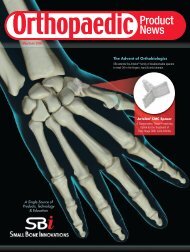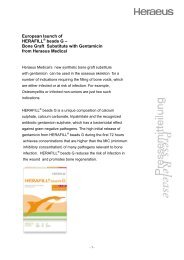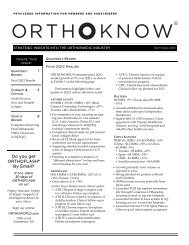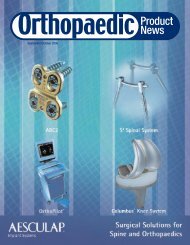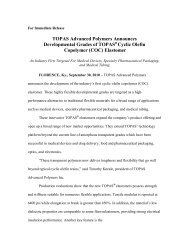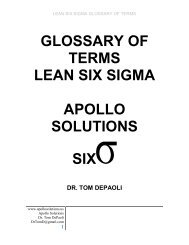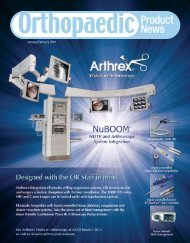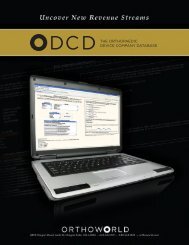Hip & Knee Surgery - Orthoworld
Hip & Knee Surgery - Orthoworld
Hip & Knee Surgery - Orthoworld
You also want an ePaper? Increase the reach of your titles
YUMPU automatically turns print PDFs into web optimized ePapers that Google loves.
SURGEON AS ENTREPRENEURcontinued from page 54the invention is and how it is distinguishable over the relevant priorart. Upon this basis, the applicant can then provide a meaningfuland effective Response/Amendment to the examiner’s OfficeAction and the application, if deserving, can proceed to allowanceand issuance as a U.S. patent.It is clear that if the examiner had the benefit of a better understandingof the invention and how it is distinguished over the relevantprior art much earlier in the process, before he is required to submit afirst Office Action on the merits, the entire dialogue between applicantand examiner would be more meaningful and productive. The applicantwould then, in fact, have an improved opportunity in his submissionof the first Response/Amendment to satisfy the examiner’sobjections, because those objections would be founded on a muchimproved understanding of the invention. It is thus conceivable thatthe number of first action allowances, which are relatively rare today,could increase substantially if the first Office Action and the firstResponse/Amendment were better done thanks to the improvedunderstanding of both parties’ positions early in the prosecutionprocess. This improved understanding by the examiner early in theprocess would be a direct result of the opportunity for the applicant tointerview with the examiner before he issues his first Office Action.Having an understanding of the basic process and advantages ofthe first action interview, let us now briefly consider the enhancementsto the process as permitted by the recently initiatedEnhanced First Action Interview Pilot Program.First, as already discussed, the Enhanced program expands thepilot program across many more and varied Art Units in theTechnology Centers of the USPTO. Importantly, some of thosenewly involved Art Units are dedicated to examining patents relatedto surgery.Second, under the enhanced pilot program, after receiving thePre-Interview Communication from the patent examiner, the applicantis given greater flexibility in selecting the level of the revisedprocedures they will need to advance the patent prosecution duringthe period of the pilot program. Under the initial pilot program, allparticipating patent applicants had to go through all phases of theprescribed test process in a lock-step fashion.A third revision to the pilot program allows the time period setfor a reply to the examiner’s Pre-Interview Communication to beextendable by one additional month. Under the initial pilot program,the time period established for the applicant’s reply to theexaminer was non-extendable.A final major improvement to the processes prescribed for thepilot program is that if the applicant fails to timely reply to the Pre-Interview Communication or to timely conduct the first actioninterview, the result will be that the examiner will proceed to entera first office action on the merits similar to waiving the interviewand much the same as the process of a conventional non-pilot programprosecution procedure. In the initial pilot program, the rulesset down for the pilot program test period if a timely reply was notmade by the applicant the application was abandoned. Needless tosay, this harsh rule of the initial pilot program procedure discouragedapplicants for voluntarily entering the pilot program.The procedure for the Enhanced First Action Interview PilotProgram offers more benefits and flexibilities to the participantsthan the initial pilot program. Therefore, for applications in whicha request for the initial First Action Interview Pilot Program hasbeen accepted by the USPTO, but a Pre-Interview Communicationhas not been provided to the applicants, the application will beprocessed under the procedure for the Enhanced First ActionInterview Pilot Program.The intention of this article is only to provide the reader with anupdate of the Enhanced First Action Interview Pilot Program andthe initiative to involve some surgery related patent applications inexpanded program. If successful, the pilot program will probablybe fully incorporated into U.S. Patent Office patent prosecution proceduresand serve to promote an early substantive dialogue thatmay dramatically increase the understanding and cooperationbetween the inventor and the examiner. It can be reasonably expectedthat the improved early communication and understanding willresult in faster, fairer, and more effective prosecution of patents bythe USPTO. This article is not intended as legal advice but is providedonly to make the inventor/entrepreneur aware of this new pilotprogram and the possible benefits that it may represent.Perry Van Over is the Founding Member of Perry E. Van Over &Associates, PLLC, an intellectual property law firm specializing in patentprocurement, licensing and litigation in the technical fields of surgicalinstruments, medical devices, molecular biology, pharmaceuticals, biochemistryand polymer chemistry. He can be reached at 703-543-6456 orperryvanover@verizon.net.I am pleased to submit the following update to a topic Ibrought to your attention in my earlier article entitled “TheRules of the Road Are Changing for Patents,” (OPN,November/December 2007) That earlier articleaddressed the details of the USPTO effort to change therules of patent practice as it relates to “Claims andContinuations.” Responding to a court challenge to thoseproposed rule changes, the U.S. District Court, EasternDivision of Virginia on October 31, 2007 issued a preliminaryinjunction enjoining the USPTO from implementingchanges in the Claims and Continuations Final Rule.Readers are invited to review my earlier article in which Isummarized the proposed patent rule changes and presentedarguments as to why the proposed changes weremisguided and contrary to improving the operation of oursystem of patent laws in this country. I am now verypleased to report that the USPTO has reversed its position.The Under Secretary of Commerce for IntellectualProperty and Director of the USPTO, David Kappos, hassigned a new Final Rule rescinding the highly controversialregulations that, had they gone into effect, wouldhave unduly restricted an inventor’s capacity to protecthis intellectual property. As recognized by UnderSecretary Kappos, “The USPTO should incentivize innovation,develop rules that are responsive to its applicants’needs and help bring their products and services to market.”In rescinding the proposed rules, Kappos also said.“These regulations have been highly unpopular from theoutset and were not well received by the applicant community.In taking the actions we are announcing today, wehope to engage the applicant community more effectivelyon improvements that will help make the USPTO moreefficient, responsive, and transparent to the public.” Thisaction in rescinding the proposed rules is a major victoryfor the inventors and patent applicants in this country.November/December 2009 • ORTHOPAEDIC PRODUCT NEWS 55



